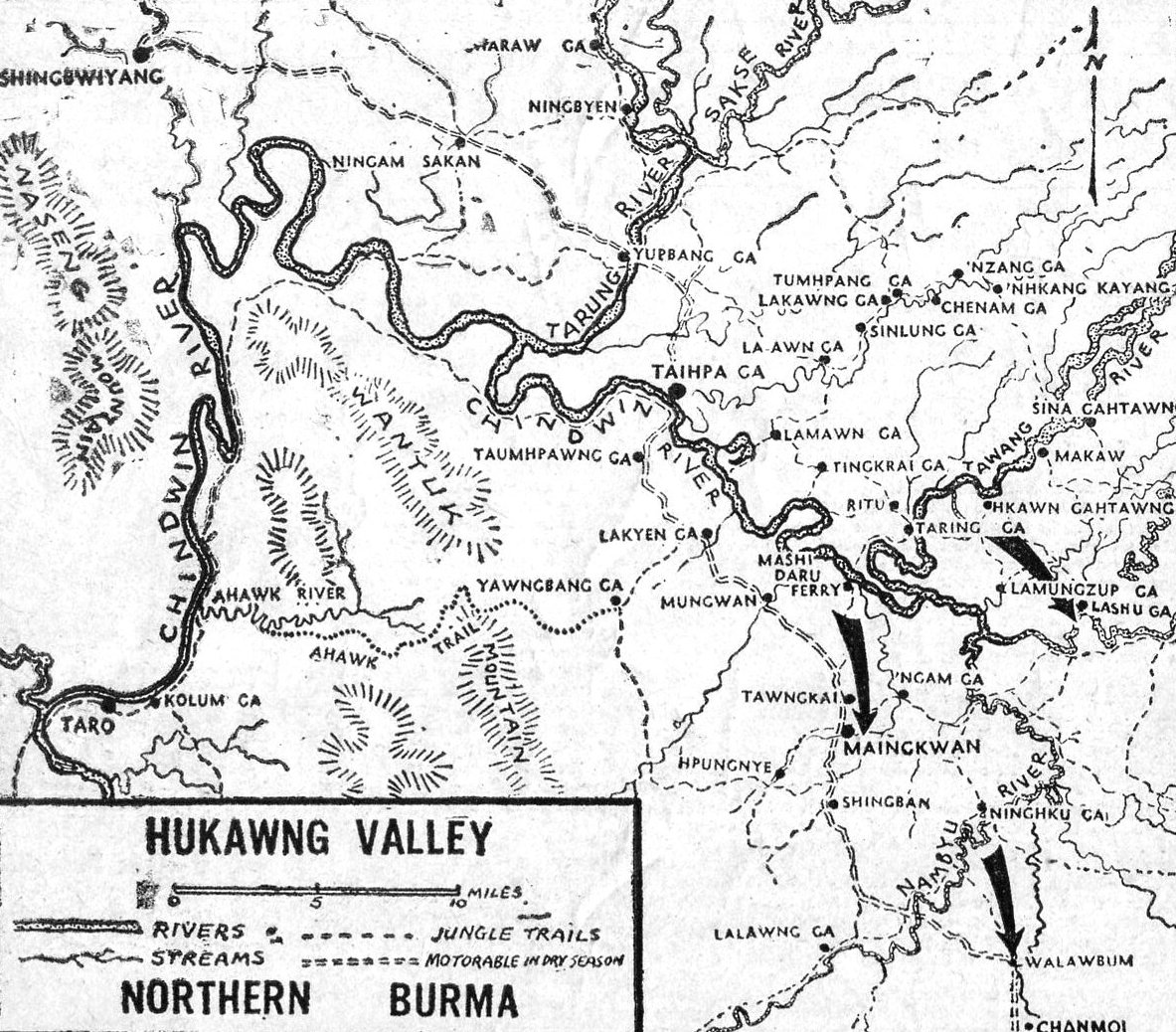
VOL. II NO. 26 REG NO. L5015 DELHI, THURSDAY MARCH 9, 1944
IN FIRST ASIATIC ACTION OF WAR
NORTHERN BURMA- "The Yanks are coming."Japanese radio blandly made this announcement three weeks ago. So there appeared only slightlikelihood that American Infantry troops, then marching up the Ledo Road, would strike their first blow with anydegree of surprise.
Today, however, the Japanese had been surprised - by the total unexpectedness of an attack deep in their rear, 10 road miles southeast of Maingkwan, their largest bastion in the Hukawng Valley.
BATTLEWISE VETERANS
The Yanks - tough, battlewise veterans of the Southwest Pacific, the Carribbean and PanamaCanal Zone - encircled an estimated 2,000 Japs by the time and the place of their unscheduled appearance. With thetaking of Walawbum, they clamped a road block between the Japanese defending Maingkwan and their escape route to thesouth.
These were the first U.S. ground forces to go into action on the Asiatic Continent in thiswar. And their initial audacious move played a large part in the courageous drive of the American-trained Chinese22nd Division storming and taking Maingkwan shortly after in a bitter, three-day assault against artillery, mortarand machine gun fire.
RUGGED MARCH
Completing a foot march of 200 miles across the rugged Naga Hills and into the Hukawng Valley. The Americans, directed by Brig. Gen. Frank Merrill, made a wide, sweeping end run around the Japanese right flank. After a short halt to rest and make last-minute preparations, they staged a five-day forced march through the chotto monsoon over little-used Kachin trails so narrow in many places that they had to forge ahead laborously single file. They traveled with pack horses and mules and were supplied by air.
When the Walawbum area was reached, Merrill's Marauders - the name adopted by American correspondents accompanying the troops - quickly siezed the village's satellite communities. Then, with one bold stroke, units under the command of Majs. Edward J. Briggs and Larry Lew moved upon Walawbum, astride the enemy artery of retreat. Resistance evaporated after brief rifle and mortar opposition. Merrill's Marauders had suffered 11 casualties - four dead, seven wounded - and the Japanese toll was reported as "25 times that amount."
Merrill, energetic, shrewd former military attache in Tokyo, promised Lt. Gen. Joseph W. Stilwell that his forces would be in Walawbum by noon. He was only 20 minutes off schedule and wired "Uncle Joe": "We have taught the Japanese some respect for us."
Stilwell inspected the Yanks as they marched toward their objective and saw them in their battledress, their grimed faces bearded and their dispositions mean, and he exclaimed, "They are the toughest bunch I've ever seen. Just the sight of them should scare the enemy."
As Merrill's Marauders moved through the Chinese lines, the word spread like wildfire through the trenches and the Chinese grinned and shouted, "Megwaw, Ding how." ("Americans okay.")
The Chinese carried out the strategy of occupying the Jap in Maingkwan, enabling the Yanks to sweep around their right flank to cut them off in the rear. A column of Maj. Gen. Sun Li-jen's 38th Division moved east along the road from Taipha Ga, while columns of Maf. Gen. Liao Yao-hsiang's 22nd Division pushed frontally and west of the road.
 She might look like a pin-up girl to you, but that isn't the reason her photograph appears here. My goodness gracious,no. Virginia Bruce, the flicker queenm attains page-one prominence because she has announced that she will run forthe California State Legislature in this year's elections. She might look like a pin-up girl to you, but that isn't the reason her photograph appears here. My goodness gracious,no. Virginia Bruce, the flicker queenm attains page-one prominence because she has announced that she will run forthe California State Legislature in this year's elections. |
The Yanks now have moved two miles west along the road to Maingkwan and, occupying positions near the Nambyu River, have destroyed many Japanese personnel and vehicles fleeing from the advancing Chinese. A strong attempt to cross the Nambyu was thrown back with heavy losses. Now the Chinese have linked forces with the Yanks below Shingban and are fighting side by side.
Before the Chinese moved in for the kill at Maingkwan, fires were seen burning in the stronghold, supporting the theory the enemy was about to flee. His escape route appeared most likely to be toward Shingban, three miles south along the road to Walawbum, although the Chinese snipped this artery from the west two days before. Shingban is believed to contain a maze of deep underground fortifications, bunker, and even an underground hospital. Stilwell felt that capturing such a position by a frontal attack would be too costly, so he deployed his forces in an enveloping movement around both flanks. Late reports, however, are that even Shingban is being evacuated.
The encircled Japs have three grim alternatives: 1-Hole in at Shingban after fighting through the Chinese and say "Come and get us, boys;" 2-Attempt to fight their way through the Americans; 3-Make their way out over the one treacherous, terrible path over the mountains on the west flank, which can be bombed and strafed continuously from the air.
Merrill's Marauders and the American-trained Chinese are using virtually the same kind of tactics adopted by the Japs against the Chinese and British in the first Burma campaign. They are continually neutralizing enemy strong points by going around and behind them. This has forced the enemy to spend most of his time fighting his way out of traps, with the consequent heavy emphasis on casualties.
Stilwell has estimated that his old enemy, Lt. Gen. Tanaka Shinchi, conqueror of Singapore,has lost most of his famous 18th Division, with remnants of two regiments, the 55th and 56th, plus a portion of the314th, virtually surrounded.
The Chinese which crossed the Idi River in the Maingkwan area were reported to have killed 74 Japs south of the stream. Enemy groups surrounded include 80 west of Maingkwan on the Idi.
Earlier reports during the week told of a Chinese advance south to the Tawang River, then the taking of Makaw, Lamungzup and Taring Ga along with the capture of considerable equipment and discovery of enemy dead. The push continued southeast and the Jap was contacted and surrounded at Lashu Ga, near the confluence of the Tabyi and Chindwin Rivers, and, at last reports, the opposition has been mopped up.
Another Chinese unit drove to the Mashi Daru Ferry along the Chindwin, ambushing and inflicting 27 casualties, including two officers, at a nearby riverbend.
Meanwhile the first pincers was clamped upon Maingkwan when the bastion was by-passed byChinese, who seized Hpungnye, three miles to the southwest. A large pocket of Japs is surrounded in this area.
The silence from the Taro area was broken when it was disclosed that a party of Japs hadfallen victim to our booby traps.
|
OF U.S. BURMA FORCE
NORTHERN BURMA - Compactly-built, energetic, pipe-smoking Frank Merrill, a brigadier general with a G.I. haicut, keen wit and a geniusfor quick, sharp decisions, is in command of the first American ground troops to launch an offensive against the Japson the Asiatic Continent in this war.
Merrill, former buck private, is one of the yougest ground combat leaders in the U.S. Army - he turned 40 only last December - and enjoys the confidence of Lt. Gen. Joseph W. Stilwell, who personally hand-picked hime to lead the spearhead of the assault to retake Burma.
WALKED OUT
When Stilwell scrambled out of Burma into India in 1942 as the Jap wave of conquest surgednorthward, Merrill, then a lieutenant colonel, was among the small, tattered, polyglot band which made its way toImphal and safety an eyelash ahead of the Japs and the monsoon. He heard Uncle Joe utter his famous vow to come backand silently made the same pledge himself.
Probably as intimately as any American, Merrill, who calls Woodstock, N.H., his home, knowsthe Jap. He was first an officer language student and later assistant military attache in Tokyo, and at all timesstudied the Nip Army, made friends with the younder officers and and kept his sharp eyes open behind his gold-rimmedglasses.
ON FLYING MISSION
On the brink of the stab in the back at Pearl Harbor, in October, 1941, Merrill left Japanfor the Philippines, where he was appointed Intelligence Officer for Gen. Douglas MacArthur.
But he missed the gallant stand at bataan because on Dec. 7 he was on a flying military mission to Rangoon. There he played a large part in getting Lend-Lease material up the Burma Road at a time when it appeared as if Jap ground and air attacks had doomed it all.
When the Stilwell mission arrived, Merrill acted as Uncle Joe's liaison officer with the British on their front. He was later awarded the Purple Heart, which at the time was being presented for distinguished service.
After the rout of the Allied forces and the classic Stilwell march, Merrill remained behind in Assam to help extricate Chinese remnants and transport them to the Chinese-American Training Center in India.
This task completed, Merrill was appointed Stilwell's G-3, stationed with the staff of the Rear Echelon in Delhi. He became one of Uncle Joe's closest, shrewdest advisers and accompanied the boss to theWashington and Cairo Conferences.
But he chaffed at being a desk soldier, and finally won command of the provisional group ofinfantry which is now fighting in the Hukawng Valley.
Merrill enlisted in the Engineere a a younster and was plucked out of the ranks in Panamato attend West Point, from which he graduated in 1929. He was sent to a special engineering course at theMassachusetts Institute of Technology. Then ordered to the Cavalry School at Fort Riley, Kans., where he becamean instructor in special weapons.
In 1937, he went to Japan to learn the language and, incidentally, to inspect all the military installation that came to view or could be turned up. He learned to read, write, speak and understand Japanese. During this period, he became acquainted with Stilwell through correspondence, the two finally meeting personally when the fortunes of war threw them together in Burma.
Stilwell Duck Hunting In Burma Jungle?
NORTHERN BURMA - That little is sacred to members of the American Infantry was indicated by the following incident:
Lt. Gen. Joseph W. Stilwell, clad in a field jacket, Chinese officer's cap and holding hiscarbine vertically between his knees, had crowded his jep into the jungle along a narrow trail to watch the AmericanInfantry slog by.
These Infantry resented all who rode, because they had to walk 150 miles to that point.One American soldier looked at Uncle Joe, apparently failed to recognize him, and declared bitingly: "I thoughtwe left the city. And here, for God's sake, is a duck hunter."
HUMP FREIGHTAGE TRIPLED FOR 1943
WASHINGTON - Leo T. Crowley, foreign economic administrator, testified before the House Foreign Affairs Committee on legislationto extend the three-year-old Lend-Lease Act another year beyond June 30.
He pointed out that "Lend-Lease is an investment in American security," and warned that failure to extend the programwould halt an essential part of the war "just at the moment when we are posed for great offensives."
Crowley declared that only if the Soviet Union and China are supplied with "more planes, guns, steel and food can theystrike at the enemy." He said there were more efforts to increase aid to China, with more cargo transported by air"over the Hump" in the last three months of 1943 than in the previous nine months.
MERRILL'S MARAUDERS ROUGH, TOUGH INFANTRYMEN
NORTHERN BURMA - Volunteers, all of them, and the roughest, toughest bunch of Infantry our Army's ever moulded together. Such is thecomposition of the first American combat force to set foot on the continent of Asia.
The Americans at present are slogging and slashing their way through some of the world's worst jungle on a missiondesigned to oust the Japs from Northern Burma, thereby enabling Lt. Gen. Joseph W. Stilwell to establish a landconnection with China.
Participating in this daring penetration and outflanking manuever, in cooperation with Chinese Infantry, are veteransof the Pacific victories at Papua, Guadalcanal, New Georgia; jungle-trained, eager commandos from Panama and Trinidad;and the cream of the Army's regulars and early draftees in the U.S. who have been yelling for overseas duty since Dec. 7, 1941.
Even Bataan's represented and ably, too, by 30-year-old Lt. Col. Frank Osborne, of Los Angeles, who led a Filipinobattalion, and whose subsequent escape following the surrender and arrival at Australia seven months later in a 22-foot,one-cylinder boat is one of the war's most dramatic stories.
This correspondent has spent six weeks with this crack outfit, commanded by energetic Brig.Gen. Frank Merrill, of Woodstock, N.H., one of Stilwell's ablest lieutenants, who marched out of Burma with Uncle Joetwo years ago.
I lived, trained, joked, drank with this outfit, crossed India by train with it and havealready marched more than 100 miles from northern Assam over the Ledo Road into the Hukawng Valley with it. Todaywe sever land contact with other Allied units and plunge into the jungle. Our future supplies for men and beastswill be by plane. Our only contact with the outside road is by radio.
Today the columns received the first parachuted supplies, which included everything from false teeth repaired byCapt William (Painless) Parker, of Rosedale, Miss., for a lowly private and a lieutenant colonel commanding one ofthe units which won its spurs at Guadalcanal, to oats for our sturdy Texas mules, to a portable radio transmitterwhich floated earthward attached to a jumbo chute.
Decorations are a dime a dozen in this novel outfit. A recently unpublicized ceremony was held at which were awarded medals won on Guadalcanal and New Georgia. The recipients included Sgt. Arthur Werner,Tacoma, Wash., who received the Silver Star for volunteering as a member of a rifle patrol supporting tanks whichJan. 8, 1943, knocked out a Jap stronghold on Guadalcanal which had held out three weeks; and Pfc. John Herring,Tomahawk, N.C., who received the same decoration for gallantry in the same Theater.
The unit's most decorated soldier is M/Sgt. Joseph Doyer, Clementon, N.J., who joined theCanadian Army in 1913 and throughout the World War fought in the 13th Battalion of the Black Watch Highlanders asa platoon sergeant, winning the Distinguished Conduct and Military Medals, also the Belgian Croix de Guerre. In 1919, Doyer transferred to the U.S. Army and has since served with the First, Second, 10th, 11th, 14th, 15th,19th and 27th Infantry Regiments, besides the Third Artillery. Yesterday Doyer was awarded the Legion of Meritfor outstanding organization work in the San Francisco port of embarkation.
Another top non-com is T/Sgt. John Russell, of Hammond, Ia., who won the Navy Cross andalso the Nicaragua Medal for Valor for his part in quelling an uprising. Russell's outfit killed 450 of 650 attacking outlaws.
Merrill's Marauders were created by enlisting volunteers "for dangerous and hazardous duty."Men with combat experience and jungle training were given preference. Rigid physical examinations eliminated a numberof the original volunteers; others fell by the wayside as a result of the tough training program.
Pacific units already identified by the War Dept. as in action which is represented in thisoutfit includes Wisconsin's 32nd Division, Pacific Northwest's 41st, and the 96th Pack Train, all of New Guinea; the25th and American Divisions which fought at Guadalcanal and Ohio's 37th and New England's 43rd Division which cleanedout the Solomons and New Georgia. Oregon's 186th Regiment of the 41st Division, has the highest number of officersin this volunteer unit with two captains, three majors. Even the doctors are volunteers and they carry most of theirequipment themselves.
Merrill's Marauders lost their chance of furloughs and couldn't even phone their parents andwives during their brief stay in the U.S. One soldier told me he was on a train that passed through his home town,while still another has a sister nursing in India, but hadn't been permitted to see her due to the secrecy of the mission.
Some of these troops arrived in India aboard a former luxury liner which en route stopped atAustralia. However, the troops were not permitted to leave the ship. Arriving in India, the unit was whisked towardsthe interior, where it trained on dreary, winswept plains. These rugged soldiers for months shivered nights andsweltered days. One G.I. well described the climate with a comment, "After the war they should exile Hitler and Tojoin this damn place - that's the worse sentence I can think of for anybody."
Significantly, there's been no report of AWOL's since the unit left the training camp for thefront. Until then, many a stripe was lost as these devil-may-care volunteers unconcernedly went "over the hill."I've met privates in this unit with 18 to 20 months' service who've been busted from sergeant as many as six times.They impressed me as caring nothing about rank but they are deeply interested in fighting.
Despite the rain and mud of a small monsoon, the American Infantry crossed the Ledo Road in record time and one and all were loudly cheered by a Negro band of an Engineers Regiment which played for them as theyentered the Hukawng Valley. It was fitting and proper this Negro band should be the Americans' welcoming committee,because it represented a colored outfit which started the Ledo Road two years ago and ever since they have been waiting for American combat troops to march along it.
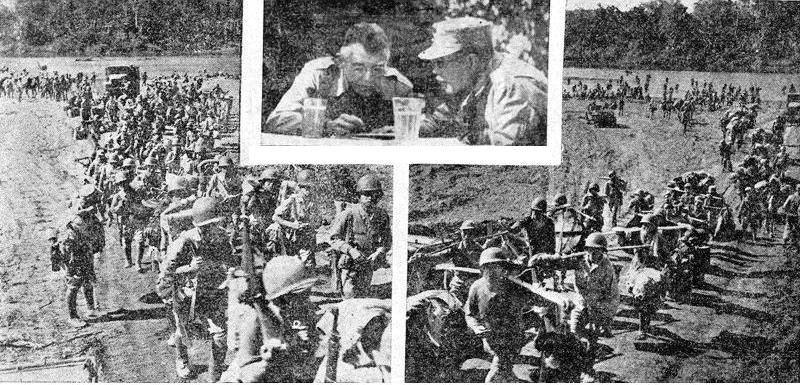
About all that the Chinese - just as everyone else - carried out of Burma during the ill-fated1942 campaign was what they had on their backs. But although the Jap wave of conquest raced up Burma like a greedyprairie fire, the Chinese salvaged hope, too . . . burning hope that one day they'd return to revenge the indignity.With Chinese patience, they waited, hope's flame never flickering, while they were equipped and trained at aChinese-American center in India and while their numbers were replenished and increased by recruits from across thecraggy backbone of the Hump.Just short of two years later, they returned to Burma, commanded by Lt. Gen. Joseph W. Stilwell, who still remembers,all too vividly, how he was forced to use his own pedal extremities to scramble to sanctity in India.Today Stilwell and his Chinese are fighting savagely and, so far, successfully to retake Northern Burma and provideelbow room for the lengthening Ledo Road.The Chinese have captured maingkwan and evidenced, to date, their superiority over Japanese forces facing them. Theywere joined this week by American doughboys, who swept past Maingkwan and seized Walawbum, five miles south. Today'sRoundup pictures introduce you to some of these Chinese G.I.'s, who have been proven, in every sense of thephrase, that they have what it takes. Sgt. ROBERT A. FUCHS 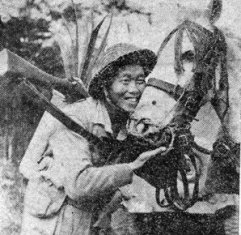 In Northern Burma, a man's best friend, next to his weapon, is often his sturdy horse.
In Northern Burma, a man's best friend, next to his weapon, is often his sturdy horse.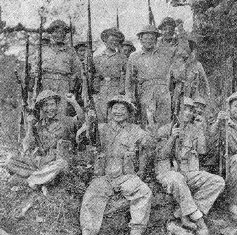 These G.I.'s are all smiles, because the Japanese have retreated and they have gained combat confidence.
These G.I.'s are all smiles, because the Japanese have retreated and they have gained combat confidence.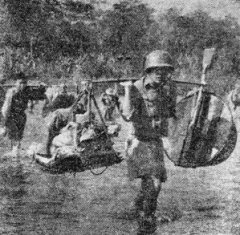 Troops, well adapted for jungle warfare, wade across a river carrying their own supplies.
Troops, well adapted for jungle warfare, wade across a river carrying their own supplies.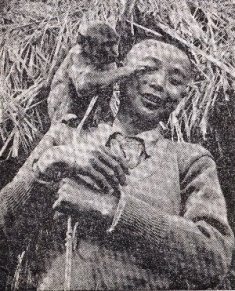 The Chinese enjoy pets and monkeys are easy to catch in the jungle.
The Chinese enjoy pets and monkeys are easy to catch in the jungle.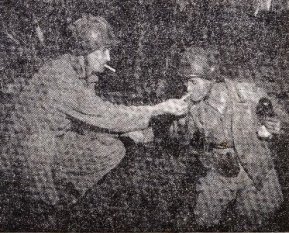 American liaison personnel accompany Chinese troops in their engagements against the enemy.
American liaison personnel accompany Chinese troops in their engagements against the enemy.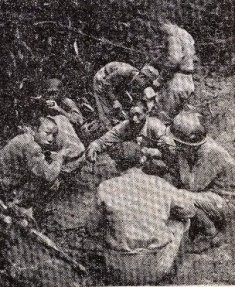 Chow call is always popular. Food is often air-dropped to the combat troops.
Chow call is always popular. Food is often air-dropped to the combat troops.
Busy Week For EAC
Nestled 'tween the towering mountains
Lies a lush and fertile land;
Part of India, old enchanted;
Part of Paradise - Assam.
Through it flows the Brahmaputra,
South from Tibet to the sea;
Down its waters steam the vessels,
Laden with her product - Tea.
Came the war with all its horrors,
Every nation bound to fight;
Men were sent to far-off places,
Pledged to contest tyrants' might.
Some of us, we lucky fellows,
Members of a favored band,
Journeyed up the Brahmaputra,
To that Paradise - Assam.
Came the winter, without fanfare,
Every day the sun was bright;
But we shivered after sunset,
Cold and damp was every night.
Came the summer, rainy season,
And we viewed each other's plight;
Used to sit up night and watch them,
Shoes, socks-floating out of sight.
Comes the peace, pray not distant,
Let me board that outbound tram;
I'll go elsewhere - you can have it,
Part of Paradise - Assam.
10 NIGHT RAIDS UPON BURMA
You can't make a week longer than seven days and nights; but in that period the Eastern AirCommand managed to cram 10 night raids and at least 20 major day raids throughout Burma, not counting numerous smallsorties.
On the night of March 6/7, RAF heavy and medium bombers sowed destruction on the airfield at Heho and the town ofBhamo.
Bhamo was hit the preceeding night by mediums, and U.S. heavies the night before started fires in attacks on airfiledsin southern Burma.
BLAZES STARTED
Heavies and mediums hit Zayatkwin and Mingaladon, near Rangoon, on the night of March 3/4,and started fires. Blazes also were started in dump areas at Prome by mediums on March 2/3. Long-range fighterspeppered Jap lines of communication by night in southern Burma. RAF mediums set stores dumps on fire at Taungup andMyebon, on March 1/2. In a double attack by RAF heavies on the Mahlwagon railway yards at Rangoon on the night ofFeb. 29, a large fire was started. The night before, U.S. heavies dropped a heavy bomb load in the railyards atMandalay, Akyab, Monywa and a Jap headquarters area at Pakokku were also attacked.
ATTACKS IN NORTH
On March 3 and 4, mediums and fighter-bombers carried out widespread attacks in the north, causing fires and explosions in troop and stores areas, damaging locomotives, rolling stock and rivercraft. Kumnyenbridge was destroyed, the runway at Shwebo airfield damaged, and two bridges near Pinlebu wrecked.
Earlier in the week, a fuel dump was set on fire at Myitkyina and an extensive stores andpersonnel concentration was attacked by a very large formation of U.S. fighter-bombers in the Sawnghka area. In twoattacks on the railroad from Kanbalu to Pyintha, U.S. medium and fighter-bombers destroyed a locomotive and badlydamages four others, shot up 75 freight cars and KO'd two bridges by direct hits. The Namkwin road bridge was alsodestroyed.
U.S. fighter-bombers attacked a river and canal bridge in the Ye-U area. Three direct hits byheavy bombs broke the river bridge in two places; two direct hits destroyed the canal bridge. Fighter-bombers attackeda fuel dump on the Mogaung-Kaimaing road, started huge fires, while another formation, attacking a large troops concentration nearby, caused heavy explosions with smoke rising to 5,000 feet.
On Feb. 29, U.S. mediums attacked two bridges north of Taungtha. The south span of one wasbroken in half, and the north span of the other was knocked out, with heavy damage to tracks at both approaches. Onthe same day, RAF and IAF fighter-bombers scored five direct hits on a bridge at Natkyigon.
DESCRIPTION OF FIGHTING
CHINESE DIVISION COMMANDER TELLS OF ACTION IN NORTHERN BURMA
WITH THE CHINESE TROOPS IN HUKAWNG (Delayed)- Chinese troops have advanced down the main Hukawng Road and pushed to within four miles of Maingkwan, largest villagein the valley. Maj. Gen. Liao Yao-hsiang, Chinese 22nd Division Commander, said that the American-trained Chinese aremeeting stiff resistance along the Maingkwan Road, where the Japanese are falling back and leaving small pockets ofresistance behind to delay the Chinese.
Short, husky, 38-year-old Liao said his troops are forced to hunt the Japanese out of the jungles to kill them beforemoving forward in force. he said the Chinese are keeping constant pressure on the retreating Japanese, who would "neverretreat, unless forced to."
AT FIGHTING FRONT
Liao keeps his headquarters close to the fighting line. Correspondents seeking him traveleddown the valley, along the enemy's retreat line, to find him. The dry-weather road along which the Japs are fallingback is littered with their leavings. The stench of their transport animals they killed before retreating is strongamong the jungle trees. Their former camps were hidden deep in the jungle undergrowth, dirty and verminous, but wellfortified.
We saw elephant's tracks in the mud along the road where the Japanese had passed within thelast few days. The American liaison officer with the 22nd Division, Col. Carleton Smith, of Wayne, Pa., said theretreating Japs had left two elephants alive, but had slashed their legs so they'd be useless to the Chinese. TheChinese, however, are treating the slashes and the elephants are healing.
Jap ox-carts are also abandoned along the road, but most of their equipment was taken with them,indicating that their retreat was orderly except where units were cut off by Chinese infiltration and flankingmovements.
MARCHES WITH TROOPS
Liao often marches with his troops when they are moving through the jungles and sometimes pathless mountains to Taro and thence back into the Hukawng, where they fought the Yawngbang and Lakyen battles. Hesaid the Japanese radio described the Taro battle as the "fiercest of all Asia," despite the comparitively smallforces involved.
In the Taro area, Liao said his troops wiped out an entire Japanese battalion and, with Chineseof the 38th Division, helped clean up at least three-quarters of a Japanese regiment. Liao said: "Our casualties weremuch less than the Japanese. In the Taro battles, their losses were about eight to our one. In Hukawng, about three toour one."
He reported that one ambush near Taro had killed 31 Japanese without a single loss. His menalso killed 10 elephants and captured two while marching from Taro toward Yawngbang. Liao said the Japanese 18thDivision, under Lt. Gen. Shinishi Tantka, which is opposing the Chinese in Hukawng, is reputed to be made up of goodjungle fighters, who fought in Malaya and Burma where Liao first came in contact with them in 1942.
Liao said the 18th Division is "over-rated tactically," but said that fighting the Japaneseis a "very difficult thing. If he leaves two or three men behind, they will fight until the last man." Maj. Gen. Dan I. Sultan, CBI deputy commander, inspects training of a Chinese artillery crew during his recent visit to a Chinese-American Training Center in India.
Maj. Gen. Dan I. Sultan, CBI deputy commander, inspects training of a Chinese artillery crew during his recent visit to a Chinese-American Training Center in India.
The bespectacled, serious general, with cropped, graying hair, gave three rules for fightingthe Japanese:
1. We must prevent their patrols from infiltration.
2. We must always have superior forces in order to prevail.
3. At decisive points, we must have a superior force. In the jungle, you can't expect one battalion to destroy a Japanese battalion. They occupy a wide front with a small force and you are forced to patrol very well and hunt theJapanese out. Therefore progress must be slow and junglewise."
Liao said the Japanese supply problem is easier to solve than ours because in the Moguang Valleythey have the Irrawaddy River, one railroad and two good roads over which to bring their supplies to the front, as wellas a good road from Mogaung to Maingkwan, but that the American air power is superior and "may well be able to repair this situation."
The Japanese began this campaign, Liao said, well supplied with horses, mules, ox-carts,elephants and even jeeps and trucks that were captured in Burma and Malaya to transport their supplies to the front.
Liao said there may be three reasons for the Japanese withdrawal. First, they may be waitingfor reinforcements. Secondly, they may be trying to gain time. And, thirdly, they may be awaiting the proper battle.
The Chinese general said that if the Chinese are able to occupy Mogaung "it will change thewhole Burma situation," giving the Chinese in the Salween area a chance to drive southward.
Liao, who served in the ranks of the Chinese Army himself, recommended five of his enlistedmen to the Generalissimo for medals. He said that one private first class, Yang Yuan Lin, killed five Japs and thenreturned with their helmets and rifles, while another, Chang Yuchen, single-handedly wiped out a machine gun nest,killing three and wounding two other Japs, although wounded himself. He returned with the Jap guns, as well as theJapanese heads.
Liao, who was educated in France, learned his English in the past couple of years while inIndia. He said: "If we fight the Japanese, we must destroy him. The Japanese are not afraid if you get behind him.If Germans or Italians are surrounded, they will surrender by the thousands, but if 100 Japanese or even three Japsare surrounded, you've got to kill them all."
Wheeler Nominated For Third Star
WASHINGTON- President Roosevelt has nominated five major generals for promotion to lieutenant general, including Maj. Gen.Raymond A. Wheeler, of the Southeast Asia Command.
The others are Richard K. Sutherland, chief of staff for Gen. Douglas A. MacArthur; John C. Lee, chief ofServices of Supply in the European Theater; Holland M. (Howling) Smith, of the Marines, now in the Central Pacific; and Courtney Hicks Hodges, commander of the Third Army at Fort Sam Houston, Tex., and also of the SouthernDefense Command.
HAYMAKER PUNCH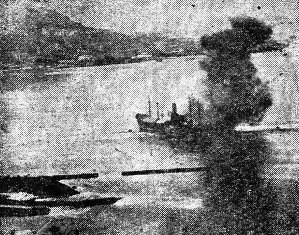 B-25 Billy Mitchell bombers of the 14th Air Force used this 520-foot Jap vessel for target practice recently.
B-25 Billy Mitchell bombers of the 14th Air Force used this 520-foot Jap vessel for target practice recently.
LANDED THIS WEEK BY 14TH AIR FORCE
14TH A.F. HQ. - Mitchell bombers of the 14th Air Force, escorted by fighters, including those of the Chinese-American Wing, thisweek tossed a haymaker punch at the Jap when they destroyed 30 to 40 enemy aircraft in the air and on the ground in anattack on Kiungshan airdrome on Hainan Island. Of this total, fighters claimed 17 definitely destroyed and four damaged, while the bombers accounted for the balance.
Other Mitchells, escorted by Lightnings, on a sweep of the Yangtze River, near Shihweiyao,sank a 120-foot river freighter. When later intercepted by 10 Japanese fighters, the American planes damaged three.Other fighters, escaorting Mitchells on a mission to Wuhu, also on the Yangtze, were attacked by two Jap fighters,shooting down one and damaging the other. The bombers then attacked and sank a 200-foot tanker. From these missions,one plane is missing.
The next day, Mitchells attacked the airdrome at Chengmai, in Thailand, destroying eighttwo-engined and one single-engined enemy aircraft on the ground. Earlier in the week, Mitchells of the Chinese-AmericanWing sank a 300-foot river boat and strafed two other vessels in the vicinity of Kiuhsienchen, on the Yangtze.Fighter-bombers sank a 160-foot launch and damaged another east of Anking.
The formation also attacked eight Japanese fighters, which fled after one was damaged. Nextthey hit the barracks area south of Tien and the railroad station and installations at Yangsin. One plane failed toreturn from these missions.
Other activities of the 14th Air Force during the past week included raids on Hongay, FrenchIndo-China, where an 1,100-ton cargo vessel was probably sunk, Campha Port and the chrome mines at Thanh Hoa, also inFrench Indo-China.
Yank To Sell at CBI Px's
Yank Magazine will be available for individual subscription starting with the March 25issue in the CBI Theater. The magazine also will be for sale at Post Exchanges for 3 As. Subscription rates will beRs. 7 per year or Rs. 3/8 for 26 weeks.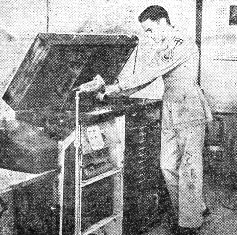 KOHLENBERG They Shall Have Music
KOHLENBERG They Shall Have Music
RADIO-VICTROLA SYSTEM
DEAR TO HEART OF WEST INDIA BASE
WEST INDIA AIR BASE - The boys of the CBI-ASC Depot Repair Squadron here enjoy the melodies that daily pour out of the combination radio-victrola amplifying system that is dear to the heart of 1st/Sgt. Charles C. Kohlenberg. However, they aren't so joyful at the "roll out," "get to work," and "douse the lights" that also come over the loudspeaker.
One switch controls the records, that include four "15-minute program" recordings. Anotherswitch brings in the radio. Another flick of the wrist calls forth the honeyed tones of Mail Clerk Sgt. Nelson W.Wyle summoning some G.I. to an interview with the C.O., or the C.O. himself, with a few words to the men. And alwaysthere is music.
The biggest problem is obtaining records. Most of the ones on hand belong to Kohlenbergpersonally, plus some donated by the Red Cross. The sergeant has been striving, as all first sergeants do, to obtainsome Army bugle call recordings, but to date his efforts have added up to a fat zero. But always there is music.
(Editor's Note: Kohlenberg plays the trumpet in civilian life. So let there be music.)
SNAKEY STORY IN ASSAM
ALONG THE LEDO ROAD - You can bet your last rupee that the next time two American soldiers who are supervising the construction of a hospital in Burma are asked by their jungle-wise Garo workmen for permission to "catch snakes," they'll watch the operation from a safe distance.
A company of these small but rugged hillsmen was clearing the underbrush from a large area near the incredible LedoRoad in Northern Burma when suddenly the surdar - Indian bossman of the group - approached Sgt. James F. Todd, ofBirmingham, Mich., and Pvt Edward J. Pfeiffer, of Philadelphia, with a request.
"My boys want permission to catch big snakes."
Todd and Pfeiffer OK'd the request, but thought it rather unusual because the Garos frequently go ahead without asking, beating the stuffing out of small snakes and game with powerful strokes of their kukris.
These snakes were different - and how!
Moving closer to a crevice where fallen bamboo trees had made an impassable obstruction, the G.I.'s saw one of theGaros roll up his sleeves and thrust his muscular arms shoulder deep into the opening.
With wide, round eyes they witnessed the startling spectacle of foot after foot of writhing reptile being pulled out ofthe hole, each foot receiving a kukri slash.
From their observation point, moved back to a safe 50 yards from the scene of the operations, the sergeant from Michiganand the private from Philly identified the overgrown body crusher as being the adonis of all reptilian wrestlers . . .the python. It measured 14 feet long and 18 inches around.
In rapid succession, four more of the same stock each measuring 9 feet in length were dragged out of the same hole . . .50 feet of python captured in less than 15 minutes.
5-2 CBI SARGE
TINIEST G.I.
IN AAF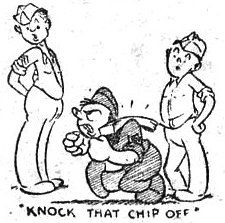
BOMBER BASE - After reading the Roundup story that S/Sgt. Robert Kessler was the smallest G.I. in the AAF, the men of a CBI Bomber Squadron held a confab and submitted their own candidate, S/Sgt. Allen D. Query, five feet, two and a half inches of fighting man.
Query weighs 104 pounds and is an aerial gunner. Despite his size, he's boss in the family, for his wife is only five feet high.
Query has 45 combat missions to his credit. He is known as "Little Devil" and has shot downtwo Jap Zeros. He has one parachute jump on the right side of the ledger and has been recommended for the Air Medaland the DFC.
The men of his squadron don't deny that Kessler, as stated in the Roundup, is "little and tough," but they submit that their ace is smaller and a little more rough.
Which all goes to show that the little things in life do count.
FIRST D.F.C.'S WON
BY PILOTS OF ASC
Awards made this week to members of the Air Service Command, India-China Wing, featured thefirst D.F.C.'s presented ASC personnel, won by Majs. Donald W. Johnson and Paul V. Morton, both test pilots.
The list included two generals, awarded Air Medals: Brig. Gens. Robert C. Oliver, commanding CBI-ASC, and Reuben C. Hood, commanding ASC activities in China.
Air Medals were also presented Col. Melville C. Robinson, who charted several aerial routesthroughout the Theater and organized, trained and equipped flight missions to Lt. Gen. Joseph W. Stilwell's HQ in theFar East over uncharted territory, exposed to enemy fire; Col. Daniel F. Callahan, now commanding ASC activities inAssam, for participation in combat missions over enemy-held territory; and Maj. David E. Pace, test pilot, who in theinfant period of combat activity in the Theater flew damaged and faulty planes from forward areas to service basesunder hazardous circumstances.
Fledgling Assam Radio Returns To Air
UP ASSAM WAY - After a short time off the air, that lusty Assam fledgling radio station
AAF, "The Voice of Special Service," was back in operation last week, this time on an "assigned frequency," bringing music, news, and even a live broadcast with a studio audience top the troops in the jungle country.
A 30-minute quiz show, the "Little Red School House of the Air," with pretty Miss Dorothy Ward of the American Red Cross as "schoolmarm," packed the G.I.'s into the local mess hall, temporarily christened "Studio A."
PROPER COACHING
There, against a backdrop painted in bright colors to depict a school room, T/5 Calvin Leichtling as M.C. lined up the contestants and coached the audience before showtime in a professional manner. A sextet billed as the "Roamin' Cowboys" brightened the proceedings with Western harmony.
With typical modesty, the audience balked at taking part in the quiz program, but six contestants were finally drafted from the ranks. Once the "quiz kids" were picked, however, numerous brash mental giants in the crowd proceeded to shout out the answers to questions, very nearly sabotaging the show.
BREATHLESS SUMMARY
T/5 Joe Wojcikowski (it says here) of Hamtramck, Mich., dragged down top prize of two cartons of cigarettes and a jar of candy by making a perfect score on a series of questions about music.
Another popular AAF feature was S/Sgt. Gene Kelly, breathless-voiced newscaster. His summary of the latest happenings on the various war fronts is flashed to the gathered soldiery on movie nights, just before the projector starts rolling in the mess hall, temporarily christened "Grauman's Assamese."
Red Cross Scores
BUT A LITTLE LATE
AIR DEPOT, CENTRAL INDIA- According to Slip-Stream, APO weekly here, Repairman Pvt. Burth was notified by the Red Cross this week thathis wife had given birth to a young Burth and that both were doing nicely.
It was very nice of the Red Cross to relieve Pvt. Burth's mind, but he would have appreciateda little quicker service. The baby was born last July. Burth had already been notified by mail from home, and, in fact,had received a lock of the offspring's hair.
JOINT WAR-NAVY DEPARTMENT
PROPOSAL UNDER STUDY FOR 10 MONTHS
WASHINGTON (UP)- A consolidation of the War and Navy Departments is planned after the war, with joint chiefs of staff already studyingthe proposal, an informed official told the United Press.
The project, with a civilian cabinet member heading the single department, has been under studyfor 10 months, but no decision has yet been reached.
The chief of staff, with authority over land, sea and air arms, would be the top militaryofficer. Air command has not yet been decided. One plan would place all land planes under Army control and allcarrier-based planes under the Navy, reversing the trend under the present system whereby division of air responsibilityis determined by the distance of operations from shore.
Russ Pay Tribute To S.O.S.
WEST INDIA PORT- The government of Soviet Russia has officially commended the work of this Port Detachment in a letter to Maj. John E. Meyer, Port Transportation Officer. It cited Maj. Meyer and M/Sgt. Alan A. Ayres and Cpl. Cyril W. Steele for "thesplendid work done by this officer and two enlisted men in effecting the transhipment of Aid-to-Russia steel for later forwarding to the USSR."
The letter was received from the Soviet Transportation Directorate in Iran and was forwarded through channels to the officer and enlisted men named by Maj. Gen. W. E. R. Covell, who stated, "I desire to express my appreciation to Maj.John E. Meyer, M/Sgt. Alan A. Ayres and Cpl. Cyril W. Steele for having performed their duties in such a manner as to reflect credit upon themselves, their organization and the Services Of Supply."
A reported 28,522 tons of steel has been transhipped through this port since it began operating under U.S. Armyjurisdiction early in 1942, in the form of pipes, rails, sheets, etc.
'SKULL AND WINGS' BIRTHDAY
B-25 BOMBER SQUADRON FLIES 1,277,950 SORTIE HOURS
SKULL AND WINGS MEDIUM BOMBER SQD. HQ.- This bomber squadron has flown 179 missions and 1,525 individual sorties for a total of 1,277,950 sortie hours inone year of combat existence that has made "Skull and Wings" a dreaded symbol to the Japs over the Burma skies.
Commanding Officer Lt. Col. Robert D. McCarten is the only flying man remaining who participated in the first missionof the squadron, the bombing of the Sagaing railroad yards.
McCarten, who leads the squadron if flying time with 391 hours and 83 missions, has been commanding officer since May 9,when he succeeded Maj. James A. Philpott. McCarten was recently awarded the Silver Star for gallantry in action - actionwhich took place when he and his five-man crew were forced to abandon their ack-ack riddled ship near the Burma border.They got back to the base after a five-day trek through the jungle.
Recently promoted to the rank of lieutenant colonel, McCarten was presented with three blasted Jap bridges by his fliers.This brought to six the number of bridges blasted in less than a week. The squadron has grown so adept in blastingbridges that it is known to the 10th Air Force as the "Burma Dental Clinic."
Xmas Gifts For Laughs
ALONG THE LEDO ROAD- This one will be funny only to guys working on the Ledo Road, that amazing project that has taken many months and manytons of sweat, blood and tears to push through.
When Christmas boxes from Shangri-La started pouring into this little jungle camp of an Engineers' outfit somewhereup the road, imagine the consternation written on four bearded, tired faces when Lt. Col. E. E. Wilhoyt, of Los Angeles, discovered a jar of theatrical vanishing cream nestled among other articles in his box.
Lt. R. J. Nugent, of Bad Axe, Mich., lifted out a smart, leather week-end bag! Says Nugent, "I ain't goin' nowhere."
Lt. John R. Peters, of Chicago, stuck in a grimy thumb and pulled out an autograph book! The first signature was thatof A. T. Steele, Chicago Daily News war correspondent, now with the Chinese drive in Northern Burma.
Finally, Lt. Fred L. Word, of Leavenworth, Kans., proudly exhibited a collapsible tie rack! Fred hasn't worn a tie forseven months.
NOTES WRITTEN IN A JUNGLE HAMMOCK
Obviously, Eugene O'Neill Never Lived In Northern Burma
SOMEWHERE IN THE BOTTOM OF A JUNGLE HAMMOCK- "Ah, wilderness."
When Eugene O'Neill wrote his play, he had probably never lived in the North Burma jungle andthe play wasn't about jungles anyway. As near as we can recall, it was about sex.
Living in the jungles of the Hukawng Valley, we see plenty of jungle, and sex is a phenomenonone never experiences, and sees only if he is studying such non-sensuous things as the population of trees and the lovelife of the scorpion. The latter is interesting, because the local variety carries a green phosphorescent light in thetail which makes the embrace look like something of a merger of a couple of neon signs on Times Square.
We'd like to see the most sex-appealing Romeo do himself any good up here. In the first place,he'd have to be able to cut a patch in the jungle, leaving a multiplicity of stumps and snags to set on - hardlyconducive to love. Then he would encounter the possessive clutch of all-encompassing brambles and, finally, therewouldn't be anybody to sit with him when he finished.
There are a few Kachin maidens around. They look a little better every day. They wear traditionallonhys, coa turbans, and amber in their ears about the size and shape of a smoker's four-bit Corona Corona.
Life and romance could be worse, however, and there are many little niceties that seldom enter the life of the chair-borne infantry. For instance, if you get thirsty and there is no boiled water about, all you have to do is to find water-containing bamboo and cut yourself a drink. You always find it, just as you are reaching thepoint of complete frustration.
Dinner, or should I say cuisine, is varied and delightful. There is corned willy and rice, then again there is corned willy and rice. There is Spam, a lunch meat, in case you haven't heard. The natives backin Shangri-La say Spam is quite a delicacy. All those planning to return under the rotation policy should considerthe prospect of Spam mixed with their hors d'ouvres at those "welcome home parties." For canapes, one may always opensome kind of rations or get some blood pudding from the Chinese. Chinese rations are reseved for Sunday dinner andspots on the tablecloth are things one seldom worries about.
It really isn't necessary to dress for dinner, because informality is the keyword. Appearingfor dinner stripped to the waist is frowned upon, but few have sufficient muscular development to so disport themselves.Dinner hours are elastic because the dinner is usually cooked by the one who is eating it.
Sleeping is where one enters the most exciting phase of his jungle life. The Napoleon bed isnot present, but in its stead is a folding monstrosity straight from the Philadelphia Quartermaster Depot, known asthe jungle hammock. This olive drab rubberized friend of insomnia is carried in a pack and hung between two trees atnight.
Its makers claim the secret is to string it tight. If you don't, you will sag like an invertedhookworm. If you do, it will just turn over on you in the night, dumping you on the ground through your mosquitonetting. This has led light sleepers to discontinue high altitude hammock stringing. Everyone says he's going to takeone home after the war for hunting trips.
The C.B.I. Roundup is a weekly newspaper published by and for the men of the United States Army Forces in China,Burma, and India, from news and pictures supplied by staff members, soldier correspondents, the United Press, and the Army News Service.The Roundup is published Friday of each week and is printed by The Statesman in New Delhi, India. Editorial matter should be sent directly to Lt. Floyd Walter, Rear Echelon Hq., U.S.A.F., C.B.I., New Delhi, and shouldarrive not later than Monday in order to make that week's issue. Pictures must arrive by Sunday and must be negatives or enlargements. Stories should contain full name and organization of sender.

MARCH 9, 1944
Original issue of C.B.I. Roundup shared by Virginia Dyer, widow of CBI veteran Stanley Dyer.
Copyright © 2008 Carl Warren Weidenburner
TOP OF PAGE PRINT THIS PAGE ABOUT THIS PAGE SEND COMMENTS
PREVIOUS ISSUE CLOSE THIS WINDOW NEXT ISSUE
